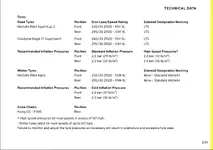Hi all, as per last update from the deal I should take delivery of my Emira in Jan 2023 (not that I believe him, but...), since I want to buy winter tires bring to be always on the safe side I've been checking what would be best for the car, after some research I've noticed that lotus, in the official Emira hand book, recommends Michelin Pilot Alpin 235/35 ZR20 front and 285/30 ZR rear (attached a picture of the page stating this).
Given that, for summer tires, they recommend Goodyear Eagle F1 Supersport 245/35 ZR20 front and 195/30 ZR20 rear I don't get why we should get smaller tires for winter.
Shouldn't be better to stick with the summer tire sizes using, for example, Continental TS 860 S?
I really don't get why the size difference, it's a sport car, we won't dig into the snow.....maybe someone could help me on this matter that could be of any help also for thers!
Thank you and sorry for my English, it needs improvements
PS according to the italian Michelin website front tires would be Pilot Alpin 4 whereas the rear ones would be Pilot Aplin 5....even different types, more and more strange to my eyes
Given that, for summer tires, they recommend Goodyear Eagle F1 Supersport 245/35 ZR20 front and 195/30 ZR20 rear I don't get why we should get smaller tires for winter.
Shouldn't be better to stick with the summer tire sizes using, for example, Continental TS 860 S?
I really don't get why the size difference, it's a sport car, we won't dig into the snow.....maybe someone could help me on this matter that could be of any help also for thers!
Thank you and sorry for my English, it needs improvements
PS according to the italian Michelin website front tires would be Pilot Alpin 4 whereas the rear ones would be Pilot Aplin 5....even different types, more and more strange to my eyes







